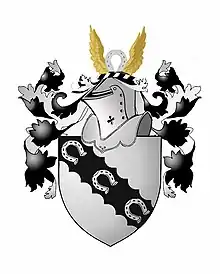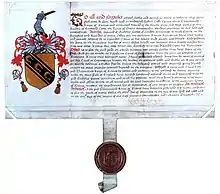Farrar (surname)
Farrar is a surname. The principal contemporary alternate spellings Farrer, Farra, '''Ferrar, Pharo occasionally, but not necessarily Farrow, and is an occupational surname for a blacksmith or ironworker - derived from the Latin ferrarius - Middle English Ferror (a smith) as an occupation, Anglo-Norman ferrur,[1] and thus shares a common occupational derivation with the most common English surname, Smith. There are records of an Osbert le ferrur and Peter le ferrour previous to the Poll tax of 1377, but in those cases ferrur is not a name, it is an occupation i.e. Thomas the horseshoer[2]
The Subsidy roll (Poll Tax of 1379), for the town of Elland, Halifax Parish, Morley Wapentake, West Riding of Yorkshire lists a Johannes de Helistones, fferror & uxor (John of Helistones, Ferror and (his) wife, indicating that he was a "ferror"; also in the same subsidy roll is Henricus de Langfeld', ffranklayn, & uxor, which translates into Henry of Langfeld, freeman and (his) wife. By 1350 surnames were taking hold in the south of England, but it wasn't until around 1450 that surnames took hold in the north ( including Yorkshire) in the 15th century[3][4]see note on Helistones as place name.
Prior to the poll tax, surnames as such did not exist, the poll tax was a head tax, one which the poor did not have to pay, but to record the head paying the tax they were identified by origin and occupation such as John of Helistones, ferror there was also a Ricardus de Helistones, Carpenter in the same town[5]
Bearers of the surname belong to various haplogroups including E-M2, I-M233, I-M253,J-M172, R-M269, R-YP5578 [6]
Origin and Appearance of the Name
The earliest documented appearance of the surname is the Register of Freemen of York, 1410-1411 with Johannes Ferror a littestar (dyer of wool or lister, litster).[7] [8]
Due to varying levels of literacy, and regional dialects the name morphs back and forth from Farrar, Pharo, Farra, Ferrar, Farrer, Ferrers, and Farrow, the name itself did not change, but the spelling of it depended upon the Scrivener
The surname is found, in England, originally in those areas in which there were deposits of iron and thus an iron producing industry.[9][10][11]
As an example of how the spelling can change over time there is the following:
Henry Ferror is listed in Halifax Wills being Abstracts and Translations 1545-1559[12] His son William Ferror's will[13]:53 His grandson John FerrarFarrer's will[13]:126–128 snd his great grandson William Farrar (settler)
Another variant: Will of Henry Fareher of Halifax 1542[14]:136
Lord (Thomas) Farrer of Abinger, in his "Farrer (and some variants) Wills and Administrations, lists many related and unrelated Farrars, with a variety of spellings who left Wills.https://archive.org/details/farrerandsomevar00farr/page/52
Armorial Bearings

There is an apparent symbiotic relationship between the surname and armorial bearings issued to various houses of Farrar/Farrer/Ferrar, all of which have, on a bend, three horeseshoes and some have a horseshoe on the crest. Such as Fairer of Warcorp Tower, Westmoreland[15]:43 And pedigrees recorded in the Visitation of Surrey[16]:157–158 and Visitation of Hertford.[17]:58 The arms of Nicholas Ferrar[18]
FERRAR of Westwood Place in Worplesdon.Arms: Argent on a bend engrailed Sable three horse-shoes of the first, a crescent for difference.Crest: A horse-shoe Argent between two wings displayed Or.As borne by Henry Farrer [Ferrer] of Westwood and his brother John Farrer of Brierly, Yorkshire, sons of John Farrer of Croxton, Lincolnshire, 2ndson of William Farrer of Ewood Hall, Yorkshire WestRiding.(see Visitation of Surrey and Hertfordshire above and Pedigrees of the Familieis of the County Yorkshire[19])
FARRER Bryan Farrer, JP, of Binnegar Hall, Dorset, (1858-1944), grandson of James William Farrer of Ingleborough, Yorkshire, Senior Master in Chancery, (1785-1863), had issue Captain John Oliver Farrer, MC, (1894-1942), father of William Oliver Farrer, MA (Oxon), of Highlands, Fernhurst, Haslemere, solicitor, (b.1926); and Sir Walter Leslie Farrer, KCVD, BA (Oxon), of Charlwood Place Farm, Horsley, solicitor, (b.1900). The said James William Farrer had a 2ndson the Rev. Matthew Thomas Farrer, MA, of Ingleborough, (1816–89), Vicar of Addington and Perpetual Curate of Shirley.)Arms: Quarterley, 1 and 4, Argent on a bend engrailed Sable three horseshoes of the field (Farrer); 2 and 3, Or gutté-de-sang a bend Gules .Crest: A horseshoe between two wings erect Proper.Motto: Ferre va ferme.
And
FARRER Thomas Farrer, 1st Baron Farrer., of Abinger Hall, Dorking, (1819–99), was created Baron Farrer of Abinger, 1893. The title became extinct on the death of Oliver Farrer, 4th Baron Farrer in 1954 .Arms: Argent on a bend engrailed Sable four horse shoes of the field.Crest: A Quatrefoil with a horse shoe between two wings all Argent.Supporters: On either side a horse reguardant Argent gorged with a riband pendant therefrom an escutcheon both Sable charged with two horseshoes palewise Argent.Motto: Ferre va ferme.[20]


In as much as the surname is occupational in origin, bearing the surname is not proof or indication of a genetic relationship, indeed at least four separate DNA haplogroups have been identified with this surname[21]
Notable Farrars
- Andrew Farrar (contemporary), Australian rugby league player and coach
- Anthony Farrar-Hockley (1924–2006), British general and historian
- Ben Farrar (b. 1986), rugby league footballer for North Queensland Cowboys, Manly-Warringah Sea Eagles, and Catalans Dragons
- Cecily Jordan Farrar (c. 1600–16??), an early female settler of the Jamestown colony
- Bernard Gaines Farrar Jr (1831–1916), American Civil War General
- David J. Farrar, (b. 1921), British engineer
- David Farrar (actor) (1908–1995), British actor
- David Farrar (New Zealand) (b. 1967), blogger
- Edgar Howard Farrar (1849–1922), U.S. corporate lawyer and political activist
- Ernest Farrar (1885–1918), English composer
- Eugenia Farrar (1875–1966), singer and philanthropist
- Frank Farrar (b. 1929), American politician from South Dakota
- Frederic William Farrar (1831–1903), British cleric, schoolmaster and writer
- Fred Farrar (c. 1883–?), rugby league footballer
- Geraldine Farrar (1882–1967), American opera singer
- James Farrar (1923–1944), British writer and poet
- Janet Farrar (b. 1950), British occultist
- Jay Farrar (b. 1966), American musician
- Jessica Farrar (b. 1966), American politician
- John Farrar (b. 1946), Australian musician
- John Chipman Farrar (1896–1974), American editor, writer and publisher, a founder of Farrar, Straus and Giroux
- John Ferrar(1588-1657) Deputy Governor/Treasurer of the Virginia Company
- John Percy Farrar (1857–1929), English mountaineer
- Lysander Farrar (1812–1876), New York
- Margaret Farrar (1897–1984), American journalist and crossword puzzle editor
- Mike Farrar (contemporary), British civil servant
- Nicholas Ferrar (1592–1637), English scholar, courtier, businessman and cleric
- Rick Lamar Farrar (b. 1960), Louisiana attorney and politician
- Robert Farrar, British writer
- Ronald T. Farrar (born 1935), American journalist and academic
- Sam Farrar (b. 1978), bassist of American rock band Phantom Planet
- Sid Farrar (1859–1935), infielder for the Philadelphia Quakers and Philadelphia Athletics
- Stewart Farrar (1916–2000), British Wiccan author, husband of Janet Farrar
- Tyler Farrar (b. 1984), American cyclist
- Vince Farrar (b. 1947), rugby league footballer
- William Farrar (1583-1637), early English settler of Virginia (1618, aboard Neptune), husband of Cecily Jordan Farrar
Fictional characters
- Edward Ferrars, character from Sense and Sensibility
See also
- Farrow (surname)
- Ferrer (surname)
Note
Helistones is a place name in the manor of Wakefield, West Riding Yorkshire, thus a name listed in the 1379 subsidy roll for Morley Wapentake, Halifax Parish as Johannes de Helistones and Ricardus de Helistones, Carpenter , Helistones is not a surname but indicates his place of origin. It is possible that their descendants adopted the name Helistones (or a variant like Elistones), Ferror, Carpenter or some other appelation depending on their occupation or location at the time[22][23]
References
- "Anglo Norman Dictionary".
- Bardsley, Charles Wareing (1875). English Surnames: Their Sources and Significations. Piccadilly, London: Chatto and Windus. p. 290.
- "Subsidy Roll of 1379, Morley Wapentake". Genuki.org.uk. Retrieved 7 February 2019.
- McKinley, Richard A. (2013). A History of British Surnames. Routledge. p. 31. ISBN 978-0-582-01869-3.
- "Middle Ages Poll Tax". Explore Genealogy. Retrieved 7 February 2019.
- "Farrar Farrow DNA results". Family Tree DNA. Retrieved 4 August 2019.
- (England), York (1896). "Register of the Freemen of the City of York: From the City ..., Volume 96". books.google.com. Retrieved 6 February 2019.
- "YORKSHIRE: Subsidy Rolls (Poll Tax) for the year 1379". genuki, org.uk. Retrieved 6 February 2019.
- "DistributionFarrar name 1881". Public Profiler UK. Retrieved 6 February 2019.
- "Iron Mining in the British Isles". Northern Mine Research Society. Retrieved 6 February 2019.
- "Roman Britain Industrial Mining" (PDF). Campbell M Gold. Retrieved 6 February 2019.
- "Halifax Wills :being abstracts and translations from the Parish of Halifax 1545-1559". Archive.org. Retrieved 6 February 2019.
- Farrer of Abinger, Lord (1936). Farrer(and some variants) Wills and Administrations. Dorking [Surrey]: Tanner and Son.
- (England), York (1904). "Will of Henry Fareher of Halifax".
- "Visitation of Cumbria and Westmoreland". Archive.org. Retrieved 7 February 2019.
- The Visitations of the County of Surrey: 1530, 1572, 1623. London: Ye Wardour Press. 1899.
- The visitations of Hertfordshire, 1572 and 1634. London. 1886.
- "The Arms of Nicholas Ferrar". A December Pilgrimage. Retrieved 7 February 2019.
- Foster, Joseph (1874). "Pedigrees of the Families of the County of Yorkshire". Archive.org. Archived from the original on 2018. Retrieved 11 February 2019.
- "Surrey Coat of Arms" (PDF). Surrey Heritage. Retrieved 10 February 2019.
- "Farrar - Farrrow DNA surname project". Farrar Farriow DNA project/Family Tree DNA. Retrieved 5 February 2019.
- "Appendix A Place names in the surnames of Wakefield subsidy roll" (PDF). University of Oklahoma Libraries. Retrieved 7 February 2019.
- "YORKSHIRE: Subsidy Rolls (Poll Tax) for the year 1379". Genuki. Retrieved 9 February 2019.
